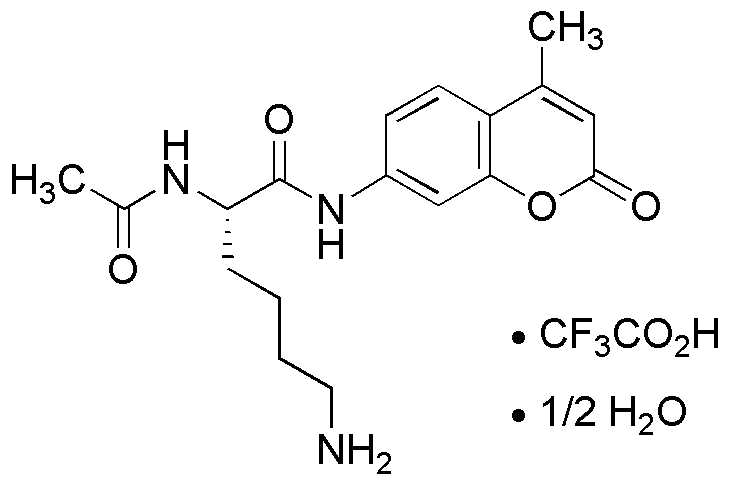Na-Acetyl-L-lysine 7-amido-4-methylcoumarin acetate salt hemihydrate is widely utilized in research focused on:
- Biochemical Research: This compound serves as a fluorescent probe in enzyme activity assays, allowing researchers to track enzyme kinetics and interactions in real-time.
- Drug Development: It is used in the synthesis of novel pharmaceuticals, particularly in the development of compounds targeting specific biological pathways, enhancing drug efficacy.
- Cell Biology: The compound aids in studying cellular processes, such as protein interactions and modifications, providing insights into cellular mechanisms and disease states.
- Diagnostics: It can be employed in diagnostic kits for detecting specific biomolecules, improving the accuracy and speed of medical tests.
- Fluorescent Labeling: Its fluorescent properties make it ideal for labeling biomolecules in imaging studies, facilitating visualization in various biological research applications.
General Information
Properties
Safety and Regulations
Applications
Na-Acetyl-L-lysine 7-amido-4-methylcoumarin acetate salt hemihydrate is widely utilized in research focused on:
- Biochemical Research: This compound serves as a fluorescent probe in enzyme activity assays, allowing researchers to track enzyme kinetics and interactions in real-time.
- Drug Development: It is used in the synthesis of novel pharmaceuticals, particularly in the development of compounds targeting specific biological pathways, enhancing drug efficacy.
- Cell Biology: The compound aids in studying cellular processes, such as protein interactions and modifications, providing insights into cellular mechanisms and disease states.
- Diagnostics: It can be employed in diagnostic kits for detecting specific biomolecules, improving the accuracy and speed of medical tests.
- Fluorescent Labeling: Its fluorescent properties make it ideal for labeling biomolecules in imaging studies, facilitating visualization in various biological research applications.
Documents
Safety Data Sheets (SDS)
The SDS provides comprehensive safety information on handling, storage, and disposal of the product.
Product Specification (PS)
The PS provides a comprehensive breakdown of the product’s properties, including chemical composition, physical state, purity, and storage requirements. It also details acceptable quality ranges and the product's intended applications.
Certificates of Analysis (COA)
Search for Certificates of Analysis (COA) by entering the products Lot Number. Lot and Batch Numbers can be found on a product’s label following the words ‘Lot’ or ‘Batch’.
*Catalog Number
*Lot Number
Certificates Of Origin (COO)
This COO confirms the country where the product was manufactured, and also details the materials and components used in it and whether it is derived from natural, synthetic, or other specific sources. This certificate may be required for customs, trade, and regulatory compliance.
*Catalog Number
*Lot Number
Safety Data Sheets (SDS)
The SDS provides comprehensive safety information on handling, storage, and disposal of the product.
DownloadProduct Specification (PS)
The PS provides a comprehensive breakdown of the product’s properties, including chemical composition, physical state, purity, and storage requirements. It also details acceptable quality ranges and the product's intended applications.
DownloadCertificates of Analysis (COA)
Search for Certificates of Analysis (COA) by entering the products Lot Number. Lot and Batch Numbers can be found on a product’s label following the words ‘Lot’ or ‘Batch’.
*Catalog Number
*Lot Number
Certificates Of Origin (COO)
This COO confirms the country where the product was manufactured, and also details the materials and components used in it and whether it is derived from natural, synthetic, or other specific sources. This certificate may be required for customs, trade, and regulatory compliance.


